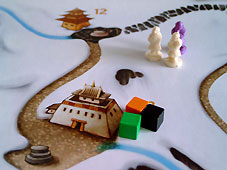Himalaya
page 3
| x |
|
|
|
|
|
|
|
|
|
|
|
|
|
|
|
|
|
|
|
|
|
|
|
|
|
|
 |
|
Because the actions have been determined in advance and cannot be changed afterwards, resolving the actions goes rather swiftly. The rate limiting step is the preceding planning phase. According to the rules, the players have one minute to plan their actions; that is more than enough, but for those who wish to play this game with the not so easily coming to a decision type of player it is advisable to invest in an hourglass! Another fun part is the method used to determine the winner, which is slightly reminiscent of Tigris and Euphrates. He who does not invest in his stupas is bound to end up with a fourth place, even though he may have the highest score in the other two categories! And increasing your livestock is only useful if you manage to make the ‘finals’; a player with an enormous livestock but not enough delegations will still remain stuck on third place.
|
| x |
|
|
|
|
|
|
|
|
|
|
|
|
|
|
|
|
|
|
|
|
|
|
|
|
|
|
| An extra dimension can be added to the game when using the advanced rules: every player gets three special event counters that can be used once, right before the planning phase. The ‘market day’ counter is placed in a village, where all players are no longer obliged to collect the least valuable good during the following turn. They can choose freely what good they wish to collect. |
|
 |
| x |
|
|
|
|
|
|
|
|
|
|
|
|
|
|
|
|
|
|
|
|
|
|
|
|
|
|
 |
|
The ‘Yeti footprint’ counter is placed on a road; a Yeti has been sighted there and no one dares to travel this road the following turn! The ‘blizzard’ counter is also placed on a road; horrible storms are raging there, and to travel this road two actions are required instead of the usual one. In conclusion, Himalaya is a not too long or complicated but fun game with enough depth. The box says a game will take approximately 90 minutes; when everybody obeys the 1 minute planning rule a game can be done even faster than that!
© 2005 Barbara Lussenburg
Himalaya, Régis Bonnessée, Tilsit, 2004 - 3 or 4 players
|
  |
|
|
|
|
|
|
|
|
|
|
|
|
|
|
|
|
|
|
|
|
|
|
  |
|
|
|
|
|
|
|
|
|
|
|
|
|
|
|
|
|
|
|
|
|
|
  |
|
|
|
|
|
|
|
|
|
|
|
|
|
|
|
|
|
|
|
|
|
|
|
|
  |
|
|
|
|
|
|
|
|
|
|
|
|
|
|
|
|
|
|
|
|
|
|
|
|
| x |
|
|
|
|
|
|
|
|
|
|
|
|
|
|
|
|
|
|
|
|
|
|
|
|
|
|
| x |
|
|
|
|
|
|
|
|
|
|
|
|
|
|
|
|
|
|
|
|
|
|
|
|
|
|
 |
|
|
|
|
|
|
|
|
|
|
|
|
|
|
|
|
|
|
|
|
|
|
 |
|
|
|
|
|
|
|
|
|
|
|
|
|
|
|
|
|
|
|
|
|
|
 |
|
|
|
|
|
|
|
|
|
|
|
|
|
|
|
|
|
|
|
|
|
|
| x |
|
|
|
|
|
|
|
|
|
|
|
|
|
|
|
|
|
|
|
|
|
|
|
|
|
|
 |
|
|
|
|
|
|
|
|
|
|
|
|
|
|
|
|
 |
|
|
|
|
|
|
|
|
|
|
|
|
|
|
|
|
|
|